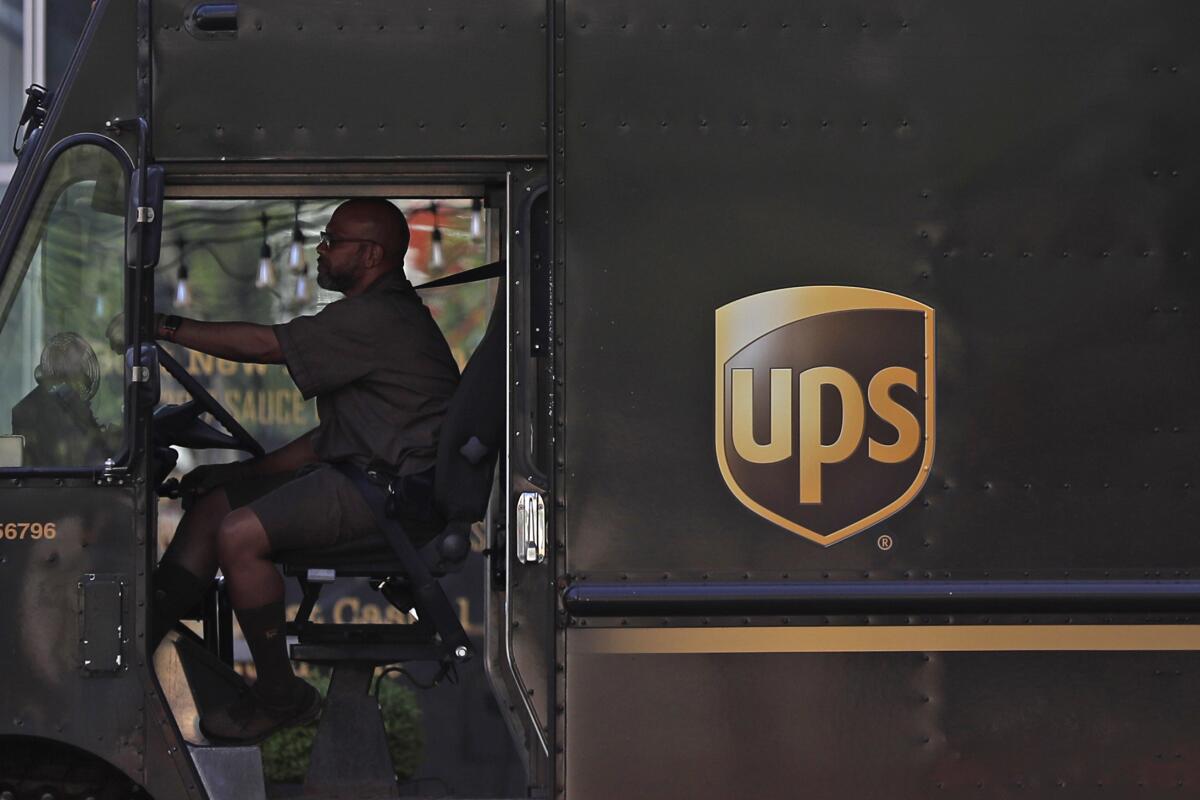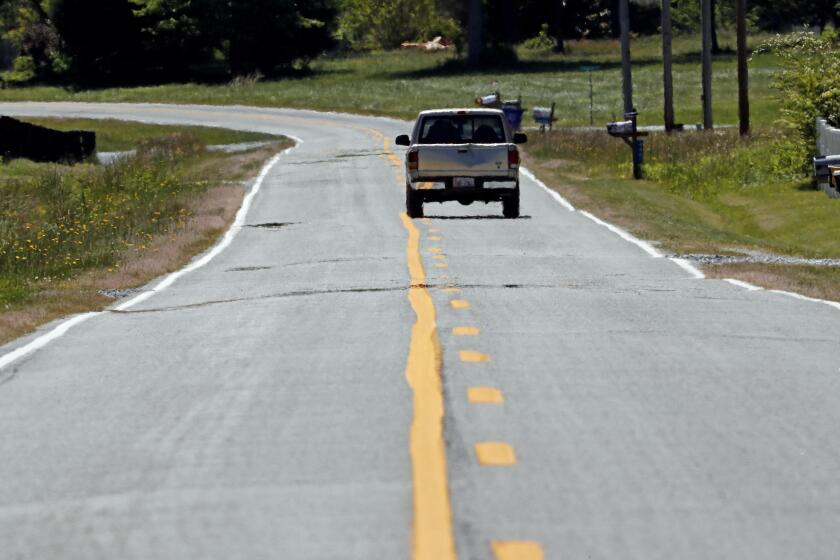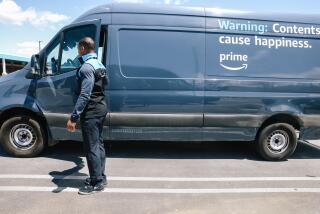Looking for work as a driver? Try delivery services

- Share via
Uber and Lyft used to be the undisputed leaders in providing jobs for independent contractors who wanted to drive for a living. The pandemic changed that. With the travel and entertainment industries in the dumpster, far fewer people are hailing rides. But practically everybody is ordering deliveries. Not surprisingly, today’s best driving jobs are in delivery.
Driving vs. delivery
The benefit of driving for delivery is that demand for drivers is brisk. And delivery jobs pose a far lower risk of coronavirus infection than picking up travelers. On the flip side, delivery is also a far more physical job, requiring drivers to jump in and out of their cars or trucks and, often, carry heavy objects.
SideHusl.com examined more than a dozen driving and delivery positions to find those that best serve the worker during these pandemic-scarred times. Our formula looks at pay, benefits, costs, risks and the chance of getting a decent amount of work.
The current lack of demand for ride-hailing has changed the landscape. In more normal times, platforms that provide rides to and from the airport would score far higher. Now they draw nothing but crickets. When travel picks up again, the best options may shift. Today, we believe the best driving jobs are in delivery.
GoShare
You have to be athletic and strong to make a living with GoShare. But if you can lift up to 75 pounds, you can earn between $33 and $67 per hour. The highest pay goes to drivers with trucks or full-size vans, however. So the net pay — after expenses — is lower.
GoShare connects people who have trucks and muscles with people who need help with moving or delivery.
But even if the net cost of operating your vehicle works out to $10 an hour, you’re still earning a good wage.
Helpers, who don’t need a vehicle, earn upward of $33 per hour.
Initially designed as a moving app, GoShare now has partnerships with several retailers and charities, such as Costco and the Salvation Army. That means a good portion of the site’s work involves local delivery rather than moving.
The main concern we have about the app is that the company holds delivery drivers liable for up to $1,000 in damages if a customer’s goods are broken in transit. Thus, you need your own commercial lines policy to cover accidental damages if you sign up to work through this app.
UPS
United Parcel Service is the nation’s biggest package delivery service. It’s also among SideHusl’s top picks for the best places to work as a delivery driver. However, it’s not a typical side hustle. UPS hires part-time drivers but prefers to hire full-time workers. And the operative word here is “hire.”
If you get a job with UPS, you will not be an independent contractor. You will be an employee. UPS will be paying at least minimum wage for each and every hour you work. The company will also pay the employer’s half of Social Security and Medicare taxes, which amount to 7.65% of your wages. And you may qualify for benefits including paid time off, health insurance and a retirement plan.
Better yet, where other delivery jobs involve using your own car and paying for your own gas, insurance and maintenance, UPS provides the truck, fuel and repairs. UPS also guarantees minimum shifts of 3.5 hours, plus regular raises.
Starting pay is a bit paltry at $14 per hour. However, you earn more with seniority. Part-time drivers can earn up to $31 hourly. Full-time drivers earn as much as $38 per hour.
Joining UPS as a driver also means joining the Teamsters Union, which imposes monthly dues that are calculated at 2.5 times your hourly wage. Thus, if you earn $14 an hour, you’ll pay $35 a month to the union.
Union dues are a minor issue if you work a lot. But if you’re available only a few hours a week, they impose a heavy burden. If you work five hours a week at $14 per hour, you’d earn about $300 a month and you’d still be on the hook for the $35 in monthly union dues. That would leave you with the equivalent of a little more than $12 per hour.
Amazon Flex
Amazon Flex promises drivers between $15 and $19 per hour, plus tips. Theoretically, that’s more than you’d earn at UPS, but there’s a huge difference. At Amazon Flex you are an independent contractor, so you pay both employer and employee contributions to Social Security and Medicare. You are also responsible for all of your expenses — gas, maintenance, insurance and repairs.
Amazon Flex drivers are presented with time “blocks” that offer a minimum and maximum pay. You have the ability to accept or ignore these offers. For instance, the company may offer a two-hour block paying $36 to $50. The minimum you can earn if you take this block is $36. However, if you receive tips, you’ll earn more.
The catch: Each block contains a set number of deliveries that Amazon believes can be completed within the time frame. But if your block takes more time, the company doesn’t pay you more.
Driver experiences are all over the map. Some drivers love the opportunity and say they earn solid returns, even after expenses. Others complain about getting delivery blocks that take far too long for the compensation provided.
Grubhub
Grubhub is one of the better food delivery apps, mainly because its pay formula includes a delivery fee, plus mileage and tips. And the company encourages tips, which are always an important component of a delivery driver’s pay. Grubhub also has an hourly minimum wage, which most other deliver apps don’t provide.
The pandemic has made ordering food from restaurants — Grubhub’s bread and butter — far more popular. Traffic and parking are easier than normal now, too. Meanwhile, customers ordering delivery appear more grateful and willing to tip generously.
Shipt
Shipt is another beneficiary of the shelter-in-place mandates. Like Instacart, Shipt enlists side hustlers to shop for groceries and deliver them to people’s homes. Since millions of people have been staying home to reduce their risk of contracting the coronavirus, Shipt shoppers have been doing brisk business.
Like Grubhub drivers, Shipt shoppers say that tips have risen over the last two months.
That’s important because this gig typically pays 7.5% of the order amount, plus a $5 delivery fee, plus tip. (In a few cities, Shipt has rolled out an alternative pay model.) Thus, if you got a $100 order, you’d earn $7.50 plus $5, or $12.50 — hardly enough to make driving, shopping and delivery worthwhile. But as order values increase and customers tip more often, shoppers say the gigs are increasingly lucrative.
Kristof is the editor of SideHusl.com, an independent site that reviews hundreds of money-making opportunities in the gig economy.
More to Read
Inside the business of entertainment
The Wide Shot brings you news, analysis and insights on everything from streaming wars to production — and what it all means for the future.
You may occasionally receive promotional content from the Los Angeles Times.











